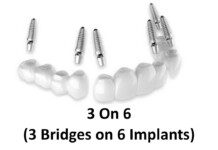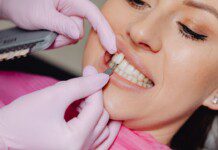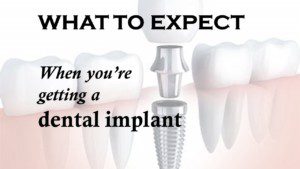
Want to know what to expect when getting dental implants? We’ve got you covered.
Today, more and more people are getting dental implants. Not only do dental implants offer a long-term solution for missing teeth, but they also provide natural-looking results, leaving you with a flawless smile.
With a 97% success rate, dental implants are by far, the best way to replace missing teeth. If you’re wondering what getting implants entails, here’s a step-by-step guide so you know what to expect:
 STEP 1: INITIAL CONSULTATION, EXAM AND X-RAYS
STEP 1: INITIAL CONSULTATION, EXAM AND X-RAYS
The first step of the process is your initial consultation. This will include a review of your medical history, a thorough oral examination, and x-rays of your mouth and jaw. The x-ray(s) will help diagnose any existing problems present with your teeth and help qualify the bone in the area needing implant treatment. This information ensures that we are fully prepared for the procedure and can foresee & effectively handle any unique situations that might affect your implants.
After your examination and x-rays, we will sit down and review all the benefits, options and risks of all your available options. Then, together, we will develop a treatment plan designed just for you and your unique needs and preferences. We will also give you a written treatment plan with all fees and basic timeline of when we expect to complete treatment. We feel it is important that patients fully understand ALL their options before beginning dental implant treatment. So, if you have questions, this is a great time to write them down and bring them with you to your appointment. Your consultation is with the Dr. and not with staff members, and this is a great opportunity to pick his brain and get answers to your questions as they pertain to your individual circumstances.
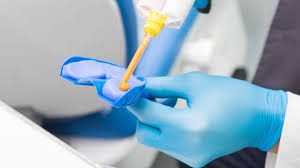
STEP 2: MOLDS/IMPRESSIONS
To help us plan your treatment, to prepare your temporary teeth, and make sure your implants are correctly placed, we will make a mold/impression of your teeth as they are right now, before treatment. This step is simple. If you’ve ever had any dental treatment including crowns or veneers, you’re familiar with the process. A gooey substance will be placed onto a U-shaped impression tray, and that tray will be placed onto your teeth. You’ll bite down for just a few seconds while the impression sets.
Once removed, the mold will harden completely to form an impression of your upper and lower jaws. Then we pour a stone material into them and create exact models of your mouth. These models/casts allow us to meticulously plan the replacement teeth to match your natural anatomy and to match the size, shape etc. of your natural teeth. However, if your natural teeth were poorly sized or shaped, etc., no problem. We can redesign ideal replacements for them, and these models make this possible.
If it is determined that we will be making a temporary tooth/temporary teeth for you to wear when the implant is initially placed, we will also use these impressions to make the temporary(ies) ahead of time to have ready for your surgery appointment.
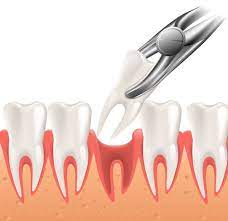
STEP 3: PRE-IMPLANT PREPARATION (EXTRACTION(s) and/or BONE GRAFTING)
If you’re getting implants in order to replace a cracked or otherwise problematic tooth, you may need to have an extraction done beforehand. This is commonly done if your dental implants will be replacing rotten, cracked, or infected teeth. Whenever possible, we will place the implants at the time of the extraction. Sometimes, however, this is not advisable (or even possible in some instances.) But we will always try to do it as soon as possible.
The area around the tooth meant to be extracted will be numbed with local anesthetic. Once you are completely numb, we will remove the tooth.
(If we are not able to place the implant at the time the tooth is removed and/or if bone grafting is necessary prior to implant placement, you’ll need to give the site time to heal before getting your implant. This wait-time can range from a few weeks for just an extraction, to a few months for bone grafting.)
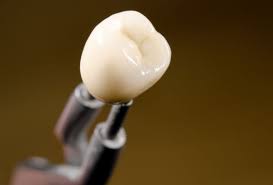
One benefit of having ALL OF your treatment done (both the surgical and the prosthetic phases) by a Prosthodontist is knowing you won’t ever have to worry about being without teeth! We will plan the temporary tooth/temporary teeth for you ahead of time (using your models, mentioned above). We have a lab here in the office and can make this for you prior to your surgery and maintain this for you throughout the implant healing phase. We’ve got you covered.
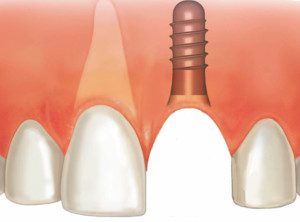
STEP 4: IMPLANT PLACEMENT
Dental implant surgery can be (and very often is) done with just local anesthetic (numbing), but sometimes patients prefer to be sedated and sleep through it all. We offer both Oral Sedation and I.V. Sedation in our office. So, if you’re nervous, just know you don’t need to be fully awake during the procedure if you don’t want to be.
If you do opt for I.V Sedation, you’ll need to avoid eating and drinking after midnight the night before, and someone will need to bring you here and drive you home safely.
Once you’re numb and comfortably sedated, we will begin the procedure. If a temporary tooth/temporary teeth are planned, we will also place it/them. We will see you for a follow-up appointment 2 weeks after the implants are placed.
Then we just wait for it to heal, and we will see you again in a few months.
STEP 5: AFTER THE PROCEDURE
TIPS FOR IMMEDIATELY AFTER THE PROCEDURE
FOR A SINGLE IMPLANT: Some people are able to go right back to work afterward, but most prefer to go home and just rest for the day. It really depends on you and how you feel afterward. See *For all implants* below
FOR MULTIPLE IMLANTS, we recommend going home, taking it easy and following the post-op instructions we review with you ahead of time.
*FOR ALL IMPLANTS*, we recommend ice, elevation, hydration, no heavy physical activity for a few days, and taking prescribed or recommended medications. You will go home with a complete list of instructions, (which will also be provided to you prior to your surgery appointment, so you’re aware ahead of time of the things to expect). You may have light bleeding for up to 24 hours.
- Use ice on the day OF surgery, 5 minutes on, 5 minutes off, to minimize swelling. (Remember, swelling=pain.)
- Keep your head elevated (head above heart) for the first 24 hours.
- Do not eat/drink anything HOT the first 24 hours.
- Avoid any alcohol first 24 hours.
- Keep your heart rate down.
- Do not exercise.
- Do not suck on straws (or anything in that manner) for 1 week.
- Take full course of antibiotics, if prescribed.
- Keep your mouth and any temporary prosthesis clean (follow instructions we provide for you).
- Many patients don’t need pain medication the day after
- Only take pain meds if you are experiencing pain.
- Do not drive if you have taken pain medication within 8 hours.
- If taking pain medication, continue to eat every 3-5 hours to keep from having nausea from medications.
- Take your daily medications as prescribed by your physician. Resume blood thinners the day after surgery or as directed by your physician.
- If the swelling, discomfort, or bleeding subside within a few days, make sure to contact us
TIPS FOR THE NEXT FEW MONTHS
Most dental implants are successful and patients adjust with ease. You can ensure your dental implant recovery is as effortless as can be by following these tips while it’s healing:
- Watch what you eat. It’s best to avoid hard and crunchy foods right after surgery.
- Keep the implant site clean. To prevent infections, your surgeon will likely recommend tips for keeping the surgery site clean. You can do a saltwater rinse, along with other actions, to help the implant site heal.
Once you’re finished with treatment, it’s important to take all the steps you can to ensure your implant will last a lifetime. Stick to a healthy oral care routine with good habits including brushing twice per day and flossing, and staying on track with regular check-ups, so we can keep an eye on it (and your other teeth) down the road.
STEP 6: FOLLOW UP PRIOR TO FINAL TOOTH/TEETH
A few months after your implant is placed, we will see you for a follow-up exam and x-ray of the implant to confirm it’s fully healed and ready to support a tooth/teeth. This visit is short and painless.
STEP 7: PLACING THE ABUTMENT: MAKING THE FINAL IMPRESSION FOR CROWN(s) / BRIDGE / Etc.
If you did not get a screw-retained temporary tooth on the day the implant was placed, the small cover screw that is on the implant will be removed, the Final Abutment will be placed, (the post that screws down into the implant, and stands above the gum line to support the new tooth/teeth) and a final impression will be made for the permanent prosthesis (implant implant crown, implant bridge, etc.). That will then go to the lab. Then you will come back in a few weeks for the permanent one.
If you did not get a screw-retained temporary tooth the day the implant was placed, the temporary abutment screw that is on the implant will be removed and the Final Abutment placed, (the post that screws down into the implant, and stands above the gum line to support the new tooth/teeth) and a final impression will be made for the permanent prosthesis (implant crown, implant bridge, etc.). That will then go to the lab. Then you will come back in a few weeks for the permanent one.
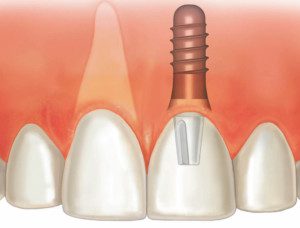
STEP 8: DELIVERY OF FINAL TOOTH/TEETH
This is the day we’ve all been waiting for. The permanent teeth are delivered and adjusted if needed, and you’re done! Congratulations!
Now, you should know what to expect when getting dental implants!
If you’ve been thinking about getting dental implants, come see us for a Complimentary Consultation. X-rays are all included. We’ll answer all of your questions, and give you several different treatment options. Or call us today to schedule a visit at 214-956-9100.

